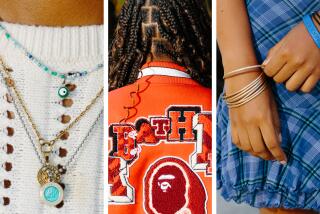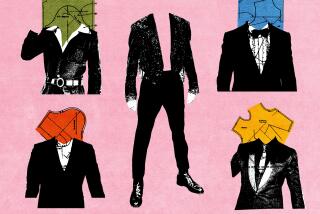All dressed up and no place to go
- Share via
As long as we humans have been wearing something other than the fur of the last animal we killed, we’ve invested much pride and envy in uniforms, official or unofficial. And, who knows, probably back then we used to notice how big was the bearskin worn by the neighbor in the next cave.
My first brush with uniforms came when I was 15. I was on the student council at a snooty New England boarding school. Feeling ourselves bold heretics against conformity, a fellow student and I argued against the requirement that boys wear coats and ties to meals. We filibustered through four weeks of meetings and lost soundly, 14 to 2.
Often, people’s first awareness of the politics of clothing has to do with military uniforms. Would men have proudly marched off to battle for so many centuries, and would crowds have cheered them on, if they did so in baggy sweatsuits? Indeed, less than a decade after my own heroic stand against coats and ties, I found myself a U.S. Army private. Extremely worried that I might be sent to Vietnam, I was nonetheless startled to find that I still rather liked wearing the uniform. My unit was entitled to an extra badge or two, and I made sure these frills were in place on my uniform before riding the bus home on weekends. In taking on the subject of uniforms, Paul Fussell has tackled something rich in possibilities.
Someone once said of Edmund Wilson that he was so good a critic that after reading him, you almost didn’t need to read the books he wrote about. If there is any living writer of whom one could say the same, it’s Fussell. At his best he is a passionate, insightful guide to a wide range of intellectual territory. His “Abroad: British Literary Traveling Between the Wars” is a fascinating analysis of an entire literary genre and of what it reveals of the mood of its era. “Wartime: Understanding and Behavior in the Second World War” shows with equal brilliance how the “good war” to defeat fascism was as filled as all other wars with needless suffering, massive incompetence and a fog of sanitized upbeat news for the folks back home. And his masterpiece, “The Great War and Modern Memory,” will still be read decades from now for its deconstruction of the tragic gap between the myths believed by the British public and how World War I was actually experienced by the men in the trenches. Like the finest of imaginative literature, it’s a book that contrasts illusion and reality.
I wish I could say something remotely similar of “Uniforms: Why We Are What We Wear.” But without Fussell’s name on the cover, I wouldn’t have recognized it as his. It reads almost as if he had merely jotted down his research notes and then lost interest. He introduces the book by saying, “All my life I have had a thing about uniforms.” After a long, odd collection of facts about uniforms in history, mostly in the 20th century, a final chapter starts with an academic-journal cliche: “Uniforms have such mysterious effects on both wearers and audiences that the subject deserves fuller inquiry.”
Fussell’s tidbits range from the familiar (President Nixon’s short-lived attempt to dress White House police like Prussian soldiers) to the quirkily interesting (when World War II veterans want to be buried in uniform, the originals are often too small, and there’s a business that sells larger ones) to things that one might scribble down on note cards (the craze for torn jeans) to see if they could later be fitted into some pattern. But there is no pattern. There are rambling paragraphs on uniforms in Czarist Russia, Nazi Germany and Victorian Britain and on how those at the very top sometimes signal their topness by sporting unusually fancy uniforms (Goering, Patton) or unusually simple ones (MacArthur, Hitler). Fussell also has strong personal feelings for and against various types of U.S. military uniforms and graduation day hoods and gowns. Uniforms, he says, can variously signify our need for belonging, convey cleanliness and expertise (doctors’ white coats) or stigmatize (prisoners’ stripes). So? Fuller inquiry is, alas, indeed needed.
His strange last chapter is called “Notes Toward the Reader’s Own Theory of Uniforms.” The very title seems to say: You figure it out. It peters out into a string of titled subchapters, some only a paragraph or two long, as if these are the dregs of his notebook. There are notes on which of the various women’s World War II military uniforms lusty male soldiers found most difficult to remove, on archaic “trade uniforms” (the printer’s cap of folded newspaper, the iceman’s leather shoulder pad), on whether women find UPS or Federal Express uniforms sexier and on sun helmets. Part of the problem is that Fussell has focused on a single artifact which could be just one of many prisms through which to look at a time and place. In the end, what’s most interesting is not the uniforms, but the cultures inside them.
I have no comprehensive theory of uniforms myself. But the passing years have made me more relaxed about the whole business. Recently my wife was given an honorary degree in Norway. Male attire for the celebratory banquet was, the invitation said, “tail coats.” I felt a brief flash of the old teenage rebelliousness: a tail coat was even worse than coats and ties. But I found a shop that rented tail coats. As I approached, I saw its display window filled with a glorious array of Santa Claus suits, Easter Bunny costumes, clown suits and more. Suddenly I felt better and thought: We’re all in uniform, all the time, whether we’re trying to stand out, blend in or conform.
At the banquet that evening, it appeared that formal dress in Scandinavia apparently means any kind of formal. Most men had tail coats, but the local bishop wore a black robe and purple sash, and the Swedish ambassador, in a 19th century diplomatic uniform, looked like a Napoleonic general. Some men and women wore “national dress” -- traditional black peasant costumes with white lace trim and colorful cross-stitched designs. After dinner, a rock band played, and everyone was twisting, twirling and jitterbugging. Whatever the required uniforms for the occasion, they had all been transcended. Uniforms do show something, but it’s the people who wear them who decide how seriously to take them.
More to Read
Sign up for our Book Club newsletter
Get the latest news, events and more from the Los Angeles Times Book Club, and help us get L.A. reading and talking.
You may occasionally receive promotional content from the Los Angeles Times.










